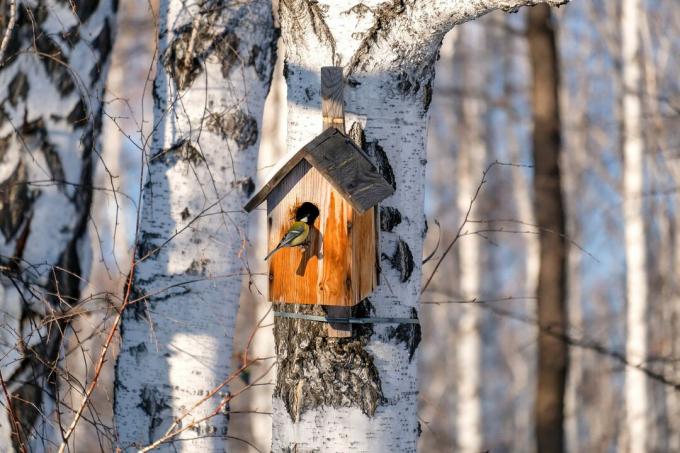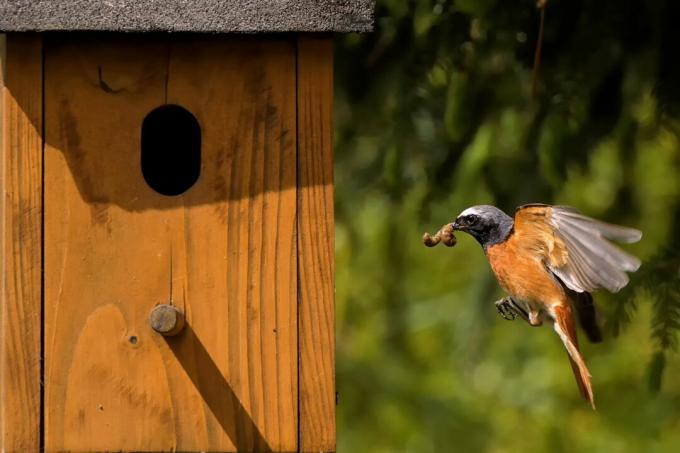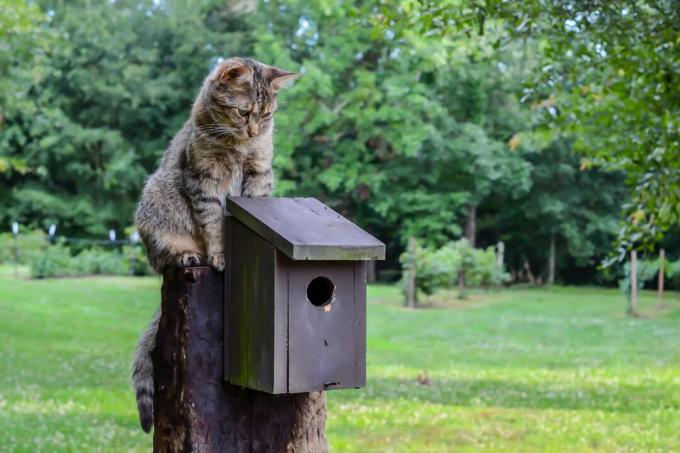How do you build a nest box yourself? What properties should it have? We share tips on building and hanging the perfect bird nesting box.

Birds are certainly one of the most popular garden animals, because their beautiful singing not only flatters our ears, but they are also exciting to watch. To lure birds into the garden, many people hang nest boxes in which the feathered animals can raise their offspring. Not only is watching the young birds a great event - building a nest box yourself is also fun and makes an important contribution to bird protection. We'll tell you now why birds need nesting boxes and what to look out for when building nesting boxes.
contents
- Why do birds need nesting boxes?
- Build your own nest box: You should pay attention to this
- This is what the perfect nest box looks like
- Correctly hang up and care for the nest box for birds
Why do birds need nesting boxes?
A common question that many ask: do birds need nesting boxes? After all, they build their own nest in nature. The reason for the need for nesting boxes actually lies with us humans: Many birds only nest in dead wood, natural caves and in suitable wall niches - but all these places are a rarity in modern landscape spaces that were created by man become. Nesting aids are an absolutely sensible alternative so that birds can still raise their offspring in a suitable location.
Nest boxes are not only helpful for birds during breeding. Many of them are happy to have sheltered accommodation, especially on cold winter nights. Since birds have to maintain a constant body temperature of 39 to 42 ° C, a night without adequate protection from the weather can be fatal for them. In fact, some species of birds are - like that House sparrow - known who set up a real winter nest in their nesting box. But also insects, squirrels or even bats like to use nesting boxes as a retreat in winter.
tip: When deciding to build a nesting box, the question arises as to which birds it can be used by at all. We provide the answer to the question "which bird builds which nest?“.

Build your own nest box: You should pay attention to this
When building a nesting box, there are a few things to consider if you want the residents to really feel at home. It already begins when you put together the material to build the nest box yourself: wood-concrete, terracotta or the classic wood are suitable. Untreated oak, robinia or larch boards are particularly suitable for building nest boxes, as they are very weather-resistant. Plywood and chipboards, on the other hand, cannot withstand wetness or cold well and are therefore hardly suitable. You should also refrain from plastic: Since it is not breathable, it collects inside from plastic bird nest boxes moisture, which in the worst case scenario leads to mold on the nest leads. There is also a lack of the necessary insulation, so that strong temperature fluctuations can occur.
If you want to design your nest box individually, you can paint your birdhouse with paints and glazes. However, it is important to ensure that the colors used meet the safety requirements for children's toys as far as possible and are, at best, biodegradable. Linseed oil is suitable, for example, as a glaze against moisture and is also absolutely harmless for birds. Bright colors also make the nest box more visible to predators. It is therefore advisable to use earthy, natural colors such as green and brown tones when painting.

Furthermore, when building a nest box, you should pay close attention to the correct dimensions: The bottom of the nest box should be at least 12 x 12 centimeters in order to provide enough space for the brood. Four holes with a diameter of five millimeters in the floor also ensure better ventilation and make it easier for the nest to dry off. In addition, the lower edge of the entrance hole should be at least 17 centimeters above the box floor and the box should have a sufficiently large roof overhang. This protects the birds from predators trying to get to the eggs.
tip: A perch even helps dangerous predators to get into the bird box, which is why you should never attach one.
This is what the perfect nest box looks like
As far as the exact appearance of the box is concerned, it is important to orientate yourself strongly to the respective bird species, because a tit box needs different conditions than a swift nesting box. The typical starling box or tit box with its rectangular shape and its round entrance hole is used by numerous species of birds. Which species moves into the nest box depends to a large extent on the size of the hole: each species of bird prefers a different size. We have compiled the entry hole sizes for the most common bird species for you here:
| 26 - 28 mm | Most of the tit species (blue tit, coal tit, marsh tit, crested tit, meadow tit) |
| 32 mm | Great tit, tree sparrow |
| 32 - 34 mm | Pied flycatcher, house sparrow |
| 32 - 45 mm | nuthatch |
| 45 mm | star |
| 48 mm high, 32 mm wide (oval) | Common redstart |

In addition to the typical tit nest boxes, there are also other nest box shapes that are used by different species of birds. Some free breeders and species that rely on breeding niches are happy about a brood aid in the "half-cave format". This nest box for robin, Graycatcher, wagtail or Wren does not have an entrance hole, but has a half-open front. They also have very special requirements Common Swift Your nesting boxes: These should be flat rather than upright and have an oval hole (6.4 x 3.2 centimeters).
Correctly hang up and care for the nest box for birds
If you have built a nesting box yourself, it is now important to install it in a suitable location. In fact, this is decisive for whether the incubator is accepted by birds. If the location is unfortunate, the best nest box will not be used. Ideally, the nesting aid should be placed about two to three meters above the ground. The entrance hole should neither point to the weather side (to the west) nor only be in the shadow area or in the blazing sun. Orientation to the southeast or east has therefore proven its worth. Suitable locations for nesting boxes are sheltered places on a tree, post or a house wall. Especially with nest boxes for robin or other half-cave breeders, make sure that the place is as inaccessible to martens or cats as possible.

The self-made nest box can then be attached to the appropriate place with stainless nails or screws so that it tilts forward slightly. Fixed wire brackets are ideal for fastening trees - these do not damage the tree and can be gently removed again if necessary. There should be a distance of at least ten meters between nesting aids of the same type so that there is no quarrel between the neighbors. The only exception: colony breeders prefer to stay together in groups. Star boxes, nesting boxes for swallows or sparrows can therefore be hung in the immediate vicinity.
If the birds are fed regularly, sufficient distance should also be kept to the feeding point: On the one hand, such places are often too restless for the brood, as many different birds have flown to them will. On the other hand, a feeding place always draws the attention of predators, so that the nesting aid is discovered more quickly. By the way, the perfect time to hang up a birdhouse is autumn: this is how the animals can Use the nesting aid as protection in winter and get to work on the construction before the start of the breeding season get used to. After hanging it up, it is best to leave the nest box alone, as too much restlessness is a deterrent for the birds.
Note: With enough space, however, a bird feeder is a perfect addition to a bird-friendly garden. With our Plantura all year round feed for example, you can support numerous garden birds both in summer and in winter with lots of energy and healthy nutrients.
The nest box only needs to be cleaned once a year to get rid of vermin and dirt. The best time to clean the nest box is in late summer, after the breeding season is over. During cleaning, old nesting material is removed and coarse dirt is brushed from the nesting aid. You can find out how to do this in our article on Cleaning nest boxes.

Would you like to do more for the birds in your garden? You can find out how to make birdseed yourself and which local shrubs are particularly suitable for birds in our articles "Make birdseed yourself: instructions & tips" and "Native shrubs for birds“.
And if you want to know how you can turn your garden into a real bird paradise, take a look at our article "Bird-friendly garden: the 10 best plants for songbirds" past.


